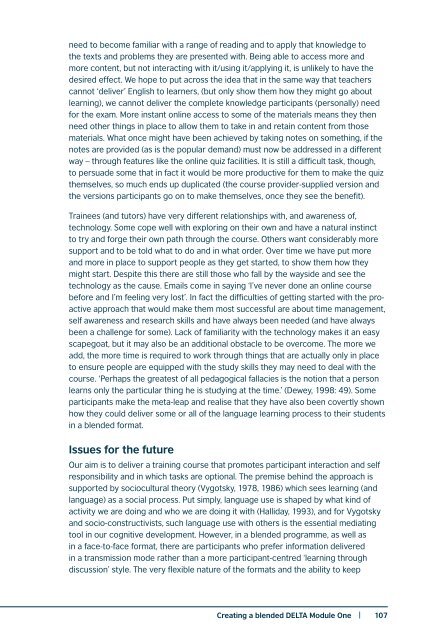Blended Learning in English Language Teaching: Course Design and Implementation
Blended Learning in English Language Teaching: Course Design and Implementation
Blended Learning in English Language Teaching: Course Design and Implementation
You also want an ePaper? Increase the reach of your titles
YUMPU automatically turns print PDFs into web optimized ePapers that Google loves.
need to become familiar with a range of read<strong>in</strong>g <strong>and</strong> to apply that knowledge to<br />
the texts <strong>and</strong> problems they are presented with. Be<strong>in</strong>g able to access more <strong>and</strong><br />
more content, but not <strong>in</strong>teract<strong>in</strong>g with it/us<strong>in</strong>g it/apply<strong>in</strong>g it, is unlikely to have the<br />
desired effect. We hope to put across the idea that <strong>in</strong> the same way that teachers<br />
cannot ‘deliver’ <strong>English</strong> to learners, (but only show them how they might go about<br />
learn<strong>in</strong>g), we cannot deliver the complete knowledge participants (personally) need<br />
for the exam. More <strong>in</strong>stant onl<strong>in</strong>e access to some of the materials means they then<br />
need other th<strong>in</strong>gs <strong>in</strong> place to allow them to take <strong>in</strong> <strong>and</strong> reta<strong>in</strong> content from those<br />
materials. What once might have been achieved by tak<strong>in</strong>g notes on someth<strong>in</strong>g, if the<br />
notes are provided (as is the popular dem<strong>and</strong>) must now be addressed <strong>in</strong> a different<br />
way – through features like the onl<strong>in</strong>e quiz facilities. It is still a difficult task, though,<br />
to persuade some that <strong>in</strong> fact it would be more productive for them to make the quiz<br />
themselves, so much ends up duplicated (the course provider-supplied version <strong>and</strong><br />
the versions participants go on to make themselves, once they see the benefit).<br />
Tra<strong>in</strong>ees (<strong>and</strong> tutors) have very different relationships with, <strong>and</strong> awareness of,<br />
technology. Some cope well with explor<strong>in</strong>g on their own <strong>and</strong> have a natural <strong>in</strong>st<strong>in</strong>ct<br />
to try <strong>and</strong> forge their own path through the course. Others want considerably more<br />
support <strong>and</strong> to be told what to do <strong>and</strong> <strong>in</strong> what order. Over time we have put more<br />
<strong>and</strong> more <strong>in</strong> place to support people as they get started, to show them how they<br />
might start. Despite this there are still those who fall by the wayside <strong>and</strong> see the<br />
technology as the cause. Emails come <strong>in</strong> say<strong>in</strong>g ‘I’ve never done an onl<strong>in</strong>e course<br />
before <strong>and</strong> I’m feel<strong>in</strong>g very lost’. In fact the difficulties of gett<strong>in</strong>g started with the proactive<br />
approach that would make them most successful are about time management,<br />
self awareness <strong>and</strong> research skills <strong>and</strong> have always been needed (<strong>and</strong> have always<br />
been a challenge for some). Lack of familiarity with the technology makes it an easy<br />
scapegoat, but it may also be an additional obstacle to be overcome. The more we<br />
add, the more time is required to work through th<strong>in</strong>gs that are actually only <strong>in</strong> place<br />
to ensure people are equipped with the study skills they may need to deal with the<br />
course. ‘Perhaps the greatest of all pedagogical fallacies is the notion that a person<br />
learns only the particular th<strong>in</strong>g he is study<strong>in</strong>g at the time.’ (Dewey, 1998: 49). Some<br />
participants make the meta-leap <strong>and</strong> realise that they have also been covertly shown<br />
how they could deliver some or all of the language learn<strong>in</strong>g process to their students<br />
<strong>in</strong> a blended format.<br />
Issues for the future<br />
Our aim is to deliver a tra<strong>in</strong><strong>in</strong>g course that promotes participant <strong>in</strong>teraction <strong>and</strong> self<br />
responsibility <strong>and</strong> <strong>in</strong> which tasks are optional. The premise beh<strong>in</strong>d the approach is<br />
supported by sociocultural theory (Vygotsky, 1978, 1986) which sees learn<strong>in</strong>g (<strong>and</strong><br />
language) as a social process. Put simply, language use is shaped by what k<strong>in</strong>d of<br />
activity we are do<strong>in</strong>g <strong>and</strong> who we are do<strong>in</strong>g it with (Halliday, 1993), <strong>and</strong> for Vygotsky<br />
<strong>and</strong> socio-constructivists, such language use with others is the essential mediat<strong>in</strong>g<br />
tool <strong>in</strong> our cognitive development. However, <strong>in</strong> a blended programme, as well as<br />
<strong>in</strong> a face-to-face format, there are participants who prefer <strong>in</strong>formation delivered<br />
<strong>in</strong> a transmission mode rather than a more participant-centred ‘learn<strong>in</strong>g through<br />
discussion’ style. The very flexible nature of the formats <strong>and</strong> the ability to keep<br />
Creat<strong>in</strong>g a blended DELTA Module One | 107


